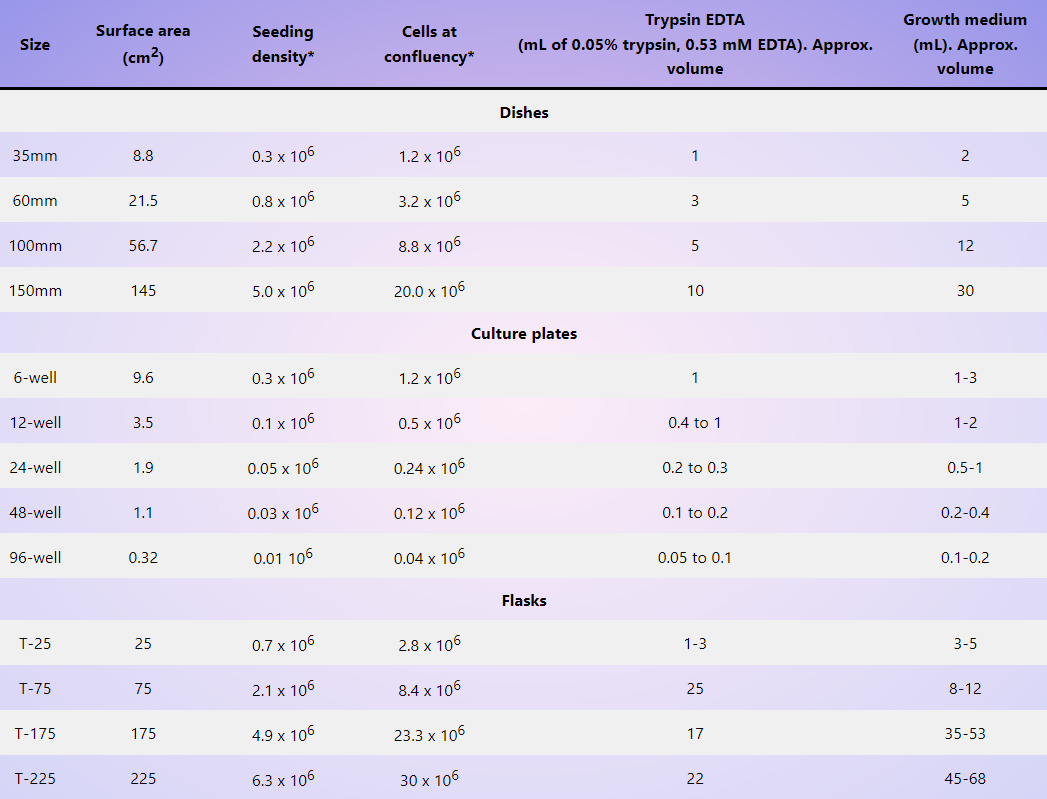Cell culture success isn’t defined by a single magic number. Instead, different stages and goals require you to track specific measurements.
Table of Contents
Cell culture, also sometimes referred to as tissue culture, is a scientific technique used to cultivate cells from multicellular eukaryotes (animals in most cases) under controlled conditions outside their natural environment.
To start a Cell culture, you need to know some basic useful numbers for cell culture that will help to properly maintain your cell culture on an everyday basis . These are mainly:
- Seeding Density
- Size of flask
- Size of Petri plates
- Volumes of culture media
- volumes of other reagents
- temperature of the culture condition
- Ph of the media
To start a cell culture first please save the below table “USEFUL NUMBERS FOR CELL CULTURE” and stick it in your cell culture room.
USEFUL NUMBERS FOR CELL CULTURE
| Size | Surface area (cm2) | Seeding density* | Cells at confluency* | Trypsin EDTA (mL of 0.05% trypsin, 0.53 mM EDTA). Approx. volume | Growth medium (mL). Approx. volume | ||
|---|---|---|---|---|---|---|---|
| Dishes | |||||||
| 35mm | 8.8 | 0.3 x 106 | 1.2 x 106 | 1 | 2 | ||
| 60mm | 21.5 | 0.8 x 106 | 3.2 x 106 | 3 | 5 | ||
| 100mm | 56.7 | 2.2 x 106 | 8.8 x 106 | 5 | 12 | ||
| 150mm | 145 | 5.0 x 106 | 20.0 x 106 | 10 | 30 | ||
| Culture plates | |||||||
| 6-well | 9.6 | 0.3 x 106 | 1.2 x 106 | 1 | 1-3 | ||
| 12-well | 3.5 | 0.1 x 106 | 0.5 x 106 | 0.4 to 1 | 1-2 | ||
| 24-well | 1.9 | 0.05 x 106 | 0.24 x 106 | 0.2 to 0.3 | 0.5-1 | ||
| 48-well | 1.1 | 0.03 x 106 | 0.12 x 106 | 0.1 to 0.2 | 0.2-0.4 | ||
| 96-well | 0.32 | 0.01 106 | 0.04 x 106 | 0.05 to 0.1 | 0.1-0.2 | ||
| Flasks | |||||||
| T-25 | 25 | 0.7 x 106 | 2.8 x 106 | 1-3 | 3-5 | ||
| T-75 | 75 | 2.1 x 106 | 8.4 x 106 | 25 | 8-12 | ||
| T-175 | 175 | 4.9 x 106 | 23.3 x 106 | 17 | 35-53 | ||
| T-225 | 225 | 6.3 x 106 | 30 x 106 | 22 | 45-68 | ||
NOW in shorts We will learn about the meaning of the numbers. These are all crucial factors to consider when setting up a cell culture experiment. Here’s a breakdown of each:
1. Seeding Density:
- Refers to the number of cells you initially plate per unit area of your culture vessel (cells/cm²).
- It impacts cell growth, proliferation, and function.
- Starting point: Resources like those from Thermo Fisher Scientific [1] provide recommended seeding densities for various cell lines.
- Factors to Consider: Optimal density depends on the specific cell line, experiment goals (e.g., studying growth vs. differentiation), and culture vessel size.
2. Size of Flask:
- Flasks come in various volumes (e.g., T25, T75) with corresponding growth surface areas (cm²).
- Choosing the right size ensures sufficient space for initial cell attachment and subsequent growth.
- Resources: Corning’s application note [2] provides tables linking flask sizes to surface areas.

3. Size of Petri Plates:
- Similar to flasks, petri dishes come in different diameters (cm²).
- The size you choose depends on the experiment and the number of replicates required.
- General Use: Smaller dishes (e.g., 6-well plates) are common for initial cell attachment and expansion, while larger ones (e.g., 10 cm) might be used for studying cell morphology.
4. Volumes of Culture Media:
- The amount of culture medium needed depends on the surface area of your vessel.
- A rule of thumb suggests using 0.2 to 0.3 mL of medium per cm² of growth surface area [2].
- Factors to Consider: Adjust volume based on cell type and their media requirements (e.g., some cells may require higher volumes for optimal growth).
5. Volumes of Other Reagents:
- This refers to volumes of additional solutions used in your experiment, such as:
- Supplements: Serums (e.g., Fetal Bovine Serum – FBS) or growth factors added to the culture medium in specific volumes depending on the cell line’s needs. Mainly 10% FBS is used for most of the cases. Antibiotics is one of the important compositions in media. (Penicilin Streptomycin is the most common among them. mainly 1% are used )
- Subculturing Reagents: Enzymes (e.g., Trypsin) used for detaching cells during passaging. The volume used depends on the cell type and culture vessel size.
- Experimental Treatments: If your experiment involves adding drugs or other test substances, the volume will depend on the desired final concentration in the culture medium.
6. Temperature of the Culture Condition:
- Most mammalian cell cultures thrive at 37°C, mimicking human body temperature.
- However, some cell lines may have specific temperature requirements.
7. pH of the Media:
- Cells have a preferred physiological pH range for optimal growth (usually around 7.4).
- Most culture media are buffered to maintain a stable pH within this range.
Key points to remember:
These are general guidelines. It’s important to consult the specific needs of your cell line and experiment for optimal results. Refer to scientific literature or established protocols for the cell line you’re using.
Important topics for cell culture:
Click here for cell reviving process
References:
- Thermofisher
- Corning
Facebook link: https://www.facebook.com/share/p/DaHcehsGeivFhKPL/?mibextid=oFDknk
Instagram link:

